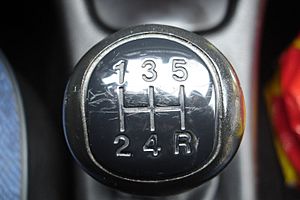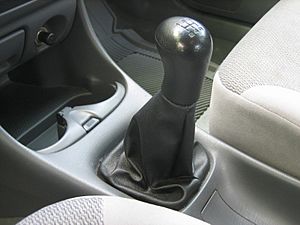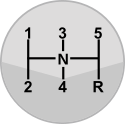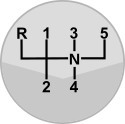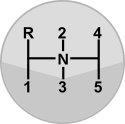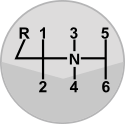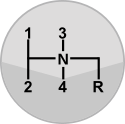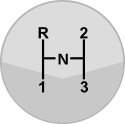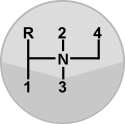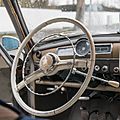Gearshift facts for kids
A gearshift (also called a gearstick or gear lever) is a metal rod in a car that helps you choose which gear the car is in. It's connected to the car's transmission, which is like the car's gearbox. In cars with a manual transmission, you use the gearshift to change gears yourself. In cars with an automatic transmission, the same rod is usually called a gear selector, and the car changes gears on its own.
Contents
Where You Find the Gearshift
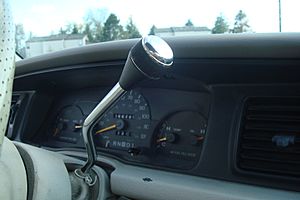
Most of the time, you'll find the gearshift between the front seats of a car. It might be on the center console or directly on the floor.
Some older cars, especially American ones, had the gearshift on the steering column. This was called a "column shift." It was handy because it allowed for a wide front seat where three people could sit. You can still find column shifts in some pickup trucks, vans, and police cars today.
A few cars, like the old Citroën 2CV, even had the gearshift on the dashboard.
In some modern sports cars, the gearshift has been replaced by "paddles." These are small levers usually found behind the steering wheel. You pull one paddle to shift up a gear and the other to shift down. Formula 1 race cars use these paddle shifters.
The Gear Knob and Its Buttons
The top part of the gearshift that you hold is called the gear knob or shift knob. It usually has a diagram on it that shows you the "shift pattern"—this is like a map of where each gear is located.
Sometimes, a gear knob might have a button. In older manual cars, this button could turn on an "overdrive" feature, which helps save fuel at high speeds. In some automatic cars, a button on the knob might let you choose a "sports mode" for faster acceleration.
It's very important to make sure a manual car is in neutral (not in any gear) before you start the engine. If the car is in gear and you try to start it, it could lurch forward or backward, which is dangerous! That's why many modern cars require you to press the clutch pedal all the way down before the engine will start. This makes sure the car won't move unexpectedly.
Automatic cars often have extra controls on or near the gearshift. These might let you choose different driving modes, like "sports" mode (for more power) or "economy" mode (for better fuel use).
Extra Gear Levers
Some four-wheel drive vehicles, especially those made for off-road adventures, have a second gear lever. This lever is used to engage a "low-ratio gearbox." This special gearbox gives the vehicle extra power at very low speeds, which is useful when driving on tough terrain like steep hills or muddy trails.
Understanding Shift Patterns
The shift pattern is simply the way the gears are arranged on the gearshift.
Manual Transmission Shift Patterns
A typical manual car with five forward gears will have seven possible positions: five for forward gears, one for reverse, and a central "neutral" position.
- Common 5-speed pattern: The most common pattern has first gear at the top left, and then you move through the gears in a pattern that usually goes left to right, top to bottom. Reverse is often at the very end of the sequence.
- Reverse lockout: To prevent you from accidentally shifting into reverse while driving forward, many cars have a special safety feature. You might need to lift, push down, or use extra force on the lever to engage reverse. Some cars even have a button you need to press.
- Dog-leg pattern: Some older sports cars and heavy trucks use a "dog-leg" pattern. This means first gear is in a different spot, often to the left and rearwards. The name comes from the zig-zag path you take between first and second gear. This design can make it easier to shift quickly between second and third gear, which are used more often in racing.
Here are some common manual shift patterns:
Automatic Transmission Shift Patterns
Automatic transmissions usually have a straight shift pattern with these common positions:
- P = Park: This locks the transmission so the car won't roll when parked.
- R = Reverse: For moving backward.
- N = Neutral: The engine is running, but no power goes to the wheels.
- D = Drive: For moving forward, and the car automatically shifts through all its gears.
Many automatic cars also have numbered positions below "Drive," like "3," "2," or "1." These let you limit the highest gear the car will use. For example, if you select "2," the car will only use first and second gears, which can be helpful for climbing steep hills or driving in snow. Some cars use an "L" (for "Low") position instead, which keeps the car in a low gear for extra power.
Some newer automatic transmissions have different patterns, like the "J-gate" (first used by Jaguar), where some gears are on one side of the "J" and others on the other side.
Some modern automatic gearboxes also have a special mode where you can push the stick forward to shift up a gear and pull it backward to shift down, giving you more control, similar to a manual car.
Images for kids
See also
 In Spanish: Palanca de cambios (automóvil) para niños
In Spanish: Palanca de cambios (automóvil) para niños


